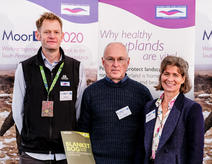Story issued by the Moorland Association
A new toolkit has been launched to enhance land managers’ understanding of the current condition of blanket bog and allow them to implement peatland restoration methods to make improvements.

There is currently more carbon stored in the UK’s peatland than in the combined forests of Britain and France, representing 42% of the UK’s soil carbon stock, so it is vitally important to keep the UK’s peatlands healthy.
The guidance, which was launched at this year’s BogFest in Edale, has been collaboratively produced by representatives of the Uplands Management Group in response to a request from DEFRA’s Uplands Stakeholder Forum for best practice guidance.
It is imperative to assess the current condition of blanket bog and this new toolkit categorises it into six different states, ranging from bare peat bog which will entail complete revegetation, to blanket bog where regular monitoring is required to ensure a favourable state is maintained.
The range of measures that can be implemented depending on the state of peat include drain blocking, restoration burning and cutting to reduce heather dominance, rewetting of peat, the reintroduction of blanket bog species, as well as careful management of livestock grazing, to name but a few.
The main benefits of peatland restoration are to increase carbon levels, improve water quality and reduce the risk of flooding, generate high levels of biodiversity, provide good quality grazing and a favourable habitat for a healthy population of red grouse.
Amanda Anderson, director of the Moorland Association, chaired the team tasked with devising the toolkit which incorporates DEFRA’s Blanket Bog Restoration Strategy. Working in conjunction with Natural England, this toolkit will play an important role in developing long-term management plans with estates.
Speaking at BogFest 2017, Ms Anderson said: “This work has been a huge collaborative effort amongst partnership organisations dedicated to peatland restoration. Being able to offer a toolkit that will allow land managers and conservation advisers to make informed decisions on best management practices is a great step forward. It will help a better understanding of the current state of the blanket bog on the land which they manage, whilst offering suitable procedures to either improve the condition of the peat or maintain its favourable state.”
Simon Thorp, chairman of the Uplands Management Group, said: “Peatland restoration is essential, particularly on areas of bare peat, which do not revegetate naturally and are continually eroding. Peatland in good condition support unique biodiversity, stores carbon, and filters water for free and has economic and community value for agriculture or sporting enterprises.
“Moorland managers on grouse moors spanning the uplands of England are already embracing measures to help safeguard the country’s peat and meet the government’s climate change targets. However, by introducing this guidance it will allow informed decisions to be made based on best practice and result in healthier areas of peatland in the long run.”
BogFest 2017, which took place from Thursday 21 – Saturday 23 September, was organised jointly by the Moors for the Future Partnership and IUCN UK Peatland Programme to acknowledge the country’s iconic uplands and blanket bogs.
The Uplands Management Group’s Blanket Bog Land Management Guidance toolkit is available:
- To view on our website
- Printed copies by emailing moors@peakdistrict.gov.uk